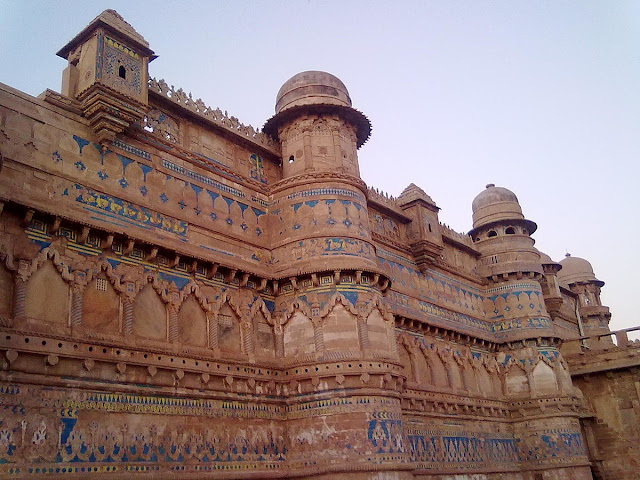Recently, six heritage sites in Madhya Pradesh - Gwalior Fort, the Historical Ensemble of Dhamnar, Khooni Bhandara in Burhanpur , Gond Memorial of Ramnagar in Mandla, Bhojeshwar Mahadev Temple and Rock Art Sites of Chambal Valley (also included in Rajasthan) have been added to the tentative list of United Nations Educational, Scientific and Cultural Organization (UNESCO) World Heritage Sites.
Gwalior’s Piece de Resistance: Gwalior Fort
Gwalior's main attraction is its formidable fort, whose 35 feet walls bear testimony to the fact that it was one of the most invincible forts of India. Within the fort you will find a number of elaborately carved sculptures and paintings. The present-day fort consists of a defensive structure and two main palaces, "Man Mandir" and Gujari Mahal, built by Tomar Rajput ruler Man Singh Tomar (reigned 1486–1516 CE).Gujari Mahal
Built in the 15th century by Raja Man Singh Tomar for his queen, Mrignayani, Gujari Mahal is a monument of love. According to popular tradition, since none of the eight queens were able to produce a heir for the king, he finally married a milkman’s daughter called “naani”, whom he named “mrignani” ((meaning beautiful eyes). Since Mrignayani wasn’t of royal heritage, Mansingh Tomar has to build a separate palace for her. Hence the Gujari Mahal came into being.
Gujari Mahal now houses Archaeological Museum.
Man Mandir Palace
Built by Raja Man Singh between 1486 and 1517, Man Mandir Palace was scene of action for many momentous events. When war of succession took place among four brothers of Mughal emperor Aurangzeb, he had one his brothers, Murad, imprisoned. Murad was later executed here in 1659 on the orders of Aurangzeb.
Other important shrines in the Gwalior fort are the11th-century Sas Bahu Ka Mandir (Temple of the Mother-in-law and the Daughter-in-law).
The Historic Ensemble of Dhamnar
The series of caves consists of 14 larger caves and 37 smaller caves. Rock cut site in Dhamnar in the Mandsaur district of Madhya Prades consists of 51 monolithic Buddhist caves and Hindu temple complex (Dharmarajeshwara temple). The caves have been mentioned in the accounts of explorers James Tod who visited the site in 1821, James Furgusson in 1845 and later by Alexander Cunningham who paid a visit to the site in 1864-65.
The presence of Buddhist caves and Dharmarajeshwara temple is illustrative of the spirit of tolerance in ancient India.
Khooni Bhandara Burhanpur
Khooni Bhandara is a 17th century AD underground water management system located in the historical city of Burhanpur in the district of the same name in Madhya Pradesh. It was built during the governorship of Abdur Rahim khan- Khanan during Mughal Emperor Jahangir’s reign. Abdul Rahim Khan-i-Khanan, popularly known as Rahim, was a medieval Hindi poet, scholar of Sanskrit and Persian and powerful minister and military commander.
Bhojeshwar Mahadev Temple
The Rajput kingdom of Paramaras ruled in Malwa and the adjacent western and central parts of India during the 9th -14th century.
The greatest ruler of the Parmara dynasty was Bhoja (1018-55) who had authored no less than 24 books on a variety of subjects including astronomy, medicine, poetics, polity, grammar, religion, architecture etc. Samaranganasutradhara, a unique work on architecture, is one of his famous works,
Gond Monuments of Ramnagar, Mandla
Built by Gond rulers the monuments of Ramnagar, Mandla consist of Moti Mahal, Raibhagat ki Kothi, Begum Mahal etc.
Rock Art Sites of Chambal Valley
Rock art sites in the hilly areas of the Vindhyan, Satpura, and Kaimur ranges.



Comments
Post a Comment